Estimated reading time: 15 minutes
Fruit damage from birds, bats, and possums is high on the list of complaints from home fruit growers. Netting is by far the most effective option to prevent damage and is one of our top three tips to protect your crop.
Sometimes it feels like we’ve grown more fruit for birds than ourselves! And it definitely feels like we’ve had every type of fruit-eating bird in our fruit trees at one time or another.
We’ve learned the hard (and heartbreaking) way that the only way to protect your precious crop from birds and other critters is with netting. If larger animals are the issue you might need to consider more serious enclosures.
Making the decision to net your fruit trees
For many gardeners, the thought of netting feels impossible. Or, they have the generous thought that they’re happy to share some of the fruit with the wildlife.
Unfortunately, the wildlife has different ideas.
Birds and other wildlife are quick to make the most of a handy food resource like a fruit tree. They will usually spread the word within their flock and bring their friends.
Once the birds have found your tree, there’s a good chance they’ll eat every piece of fruit. They also have long memories and will return year after year to the same spot.
if you want to reliably pick fruit from your tree every year then netting your fruit trees is often the reality. It’s also a key strategy for preventing fruit flies from ruining your crop.
In this blog we look at some netting options, and how they can protect your crop from most pests.
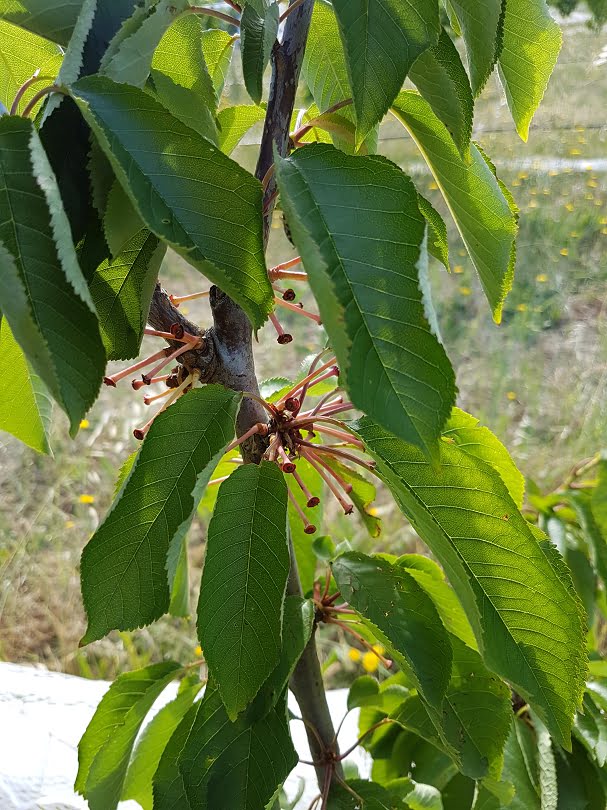
Enclosure nets
Birds just LOVE cherries. We grow cherries here on the farm and have always netted the trees. It’s been a good chance for us to learn a lot about different types of netting.
For our first cherry orchard (which had about 1000 trees), we built a complete netting enclosure around the whole orchard.
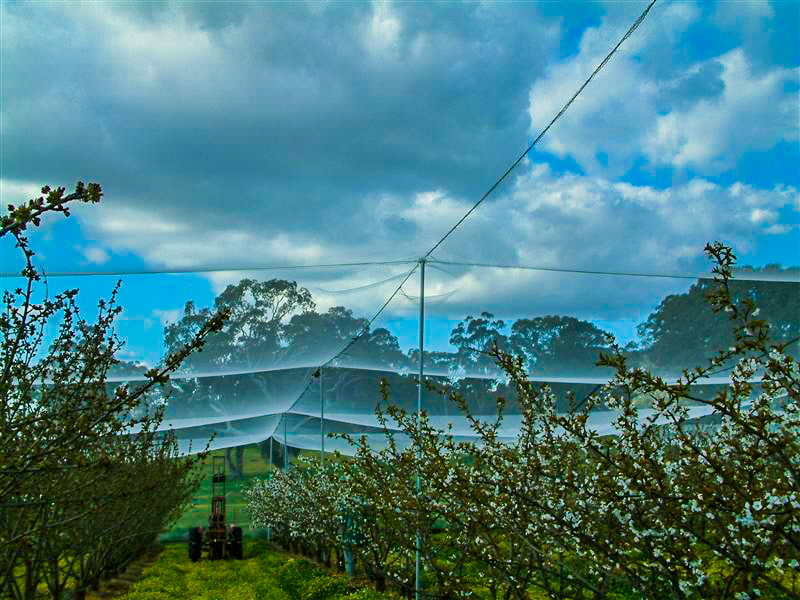
Building the enclosure and working with it over several years and through a number of storms was a fascinating experience. We learned a LOT about nets during that time.
But this is beyond the scale that most home gardeners are interested in. The next type of netting system we tried, on the new cherry orchard, is much more relevant.
Drape nets – a simple solution for backyard fruit trees
Our current cherry orchard (planted after the 2011 floods) has been protected with a simpler system called “drape netting”. It’s cheaper than a full enclosure and relatively easy to apply but has some downsides.
One is that the type of birds that love to eat cherries are particularly clever at getting under drape nets. Two of the common culprits are parrots and silvereyes.
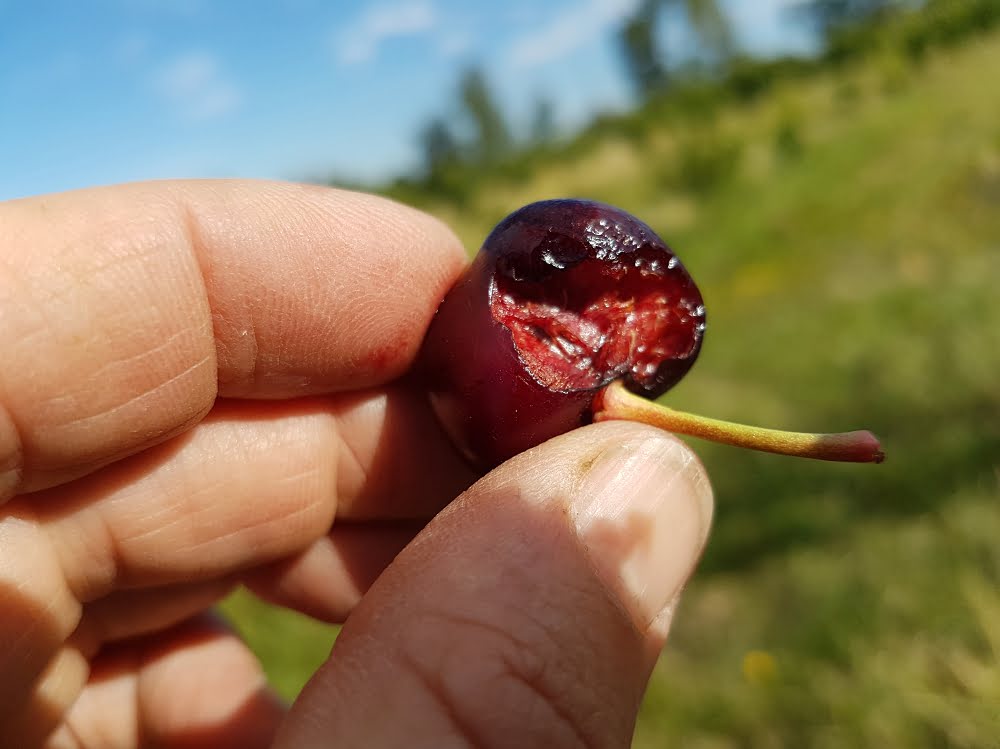
Drape netting also puts quite a bit of weight on the tree itself. This can result in branches being bent over during the growing period.
This can alter the shape of the tree, and work against your intentions for the shape. However, the effect is only seen at the top of the tree. Most of the bend can usually be removed when pruning.

Unless you are diligent about tying off the net around the trunk, drape netting often won’t stop smaller birds. Smaller birds like parrots are more inclined to nip under the edges of the net and help themselves.
The last thing on the negative side of the ledger is that nets need some care and attention. However the investment of time in looking after your nets will repay you quickly with better harvests.
The positive side of drape netting
Having told you all the bad things about drape netting, we don’t want to put you off, as it’s a useful and simple technique for lots of gardeners. So, let’s look at the plus side!
Firstly, it’s very effective against big birds like crows and cockatoos. That’s because they usually feed from above, and won’t get under the net even if there are gaps at the bottom.
Drap nets can also deter fruit bats. Like big birds, they descend on the tree from above and don’t like to get in under nets.
Despite the drawbacks, drape netting does keep the damage to a minimum and is definitely worthwhile.
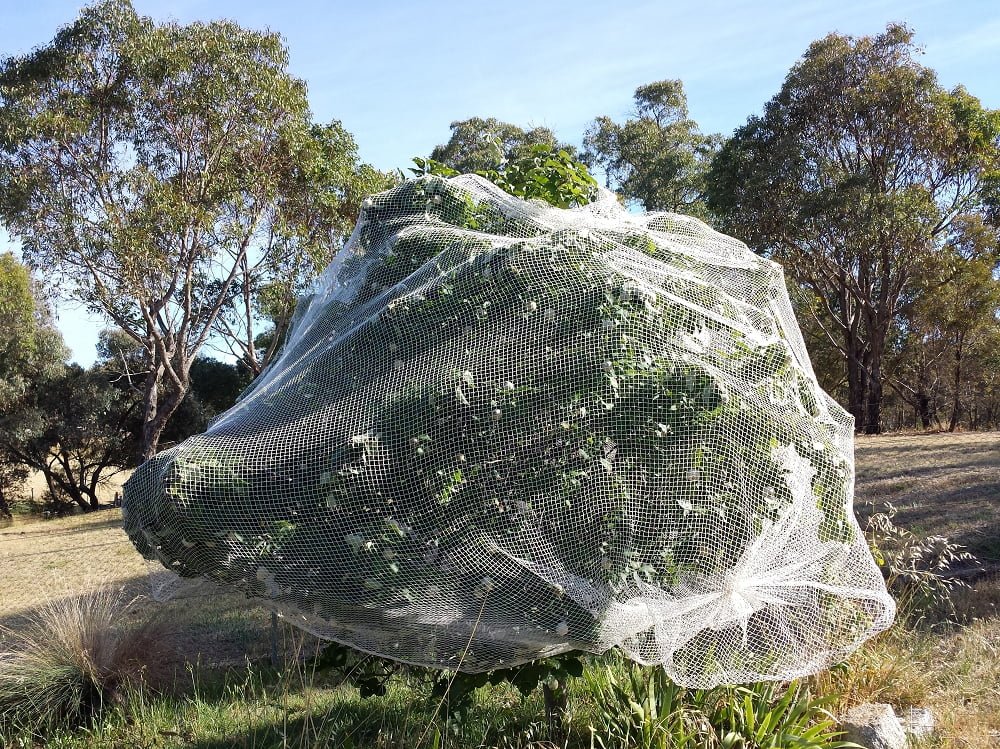
Variations on hoop nets
If you’re serious about protecting your fruit trees with nets and have the capacity to build a small enclosure, a hoop net might be just what you’re looking for.
This simple hoop net (below) has been built from star pickets and pipes. It’s one of the easiest and most effective solutions we’ve seen (and used).
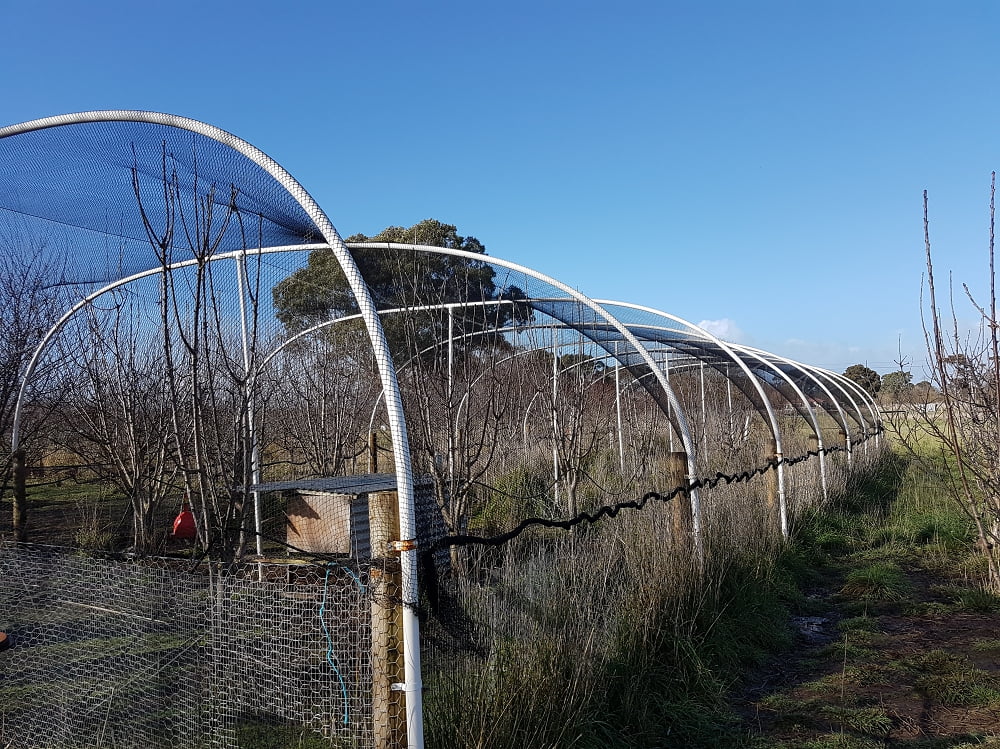
It’s easy to put up (and take down again if you choose), and easy to peg down around the perimeter to stop persistent smaller birds from getting in under the net, which can happen with drape netting.
This particular design also has wire netting around the base, which can be useful for stopping larger animals from getting into the enclosure.
The “cross-bar” system in the photo at the top of the blog is another variation on the hoop system. The key similarity is building a simple structure to hold the net off the trees.
The variations are limited only by your imagination.
How to choose the right netting system for your garden
As you can see, there are many different netting systems available, and lots of variations on the theme. Choosing the right one for your garden will depend on lots of variables.
Here’s a list of “testing questions” to ask yourself:
How many trees are you trying to protect?
The more trees you have, the more worthwhile a large enclosure becomes.
Which specific pests are you defending against?
If you’re not sure, it’s worth doing some detective work to find out exactly what’s eating your fruit. If there’s nothing eating your fruit, you may not even net to net your trees at all!
Do you have any materials available?
Access to second-hand net or having a few star pickets lying around can give you a place to start.
What’s your capacity to invest in a netting system?
They’ll almost always pay you back in the long-term, but need a capital investment to start with if you’re getting something built for you, or even if you’re buying the materials and doing it yourself. Which leads us on to…
What’s your capacity to build a netting system?
Is it something you can do yourself, or will you need to pay someone to do it? Can you hold a working bee and get some friends involved? If you’re planning to build it yourself, do the research first and look at as many different types of netting systems in other people’s yards as possible.
How big are your trees?
Even if you’re planning to build a netting enclosure eventually, when the trees are mature, you can often get away with drape netting or simple hoops for the first few years. And of course, there’s no need to net if there’s no fruit on the trees.
What other animals and plants do you have around your trees?
If you have chickens or other animals, you may want to build an enclosure to keep them inside, under your trees. Or if you’ve built beautiful beds full of a diverse mix of understory plants, you may want to keep the chickens out!
The answers to these questions will help to point you in the right direction. Once you figure out the right way to net your trees, half the work is done.
And don’t stress too much about getting it “right”. If you’re not sure what to do, start simple and invest minimally with drape net. Your netting system can evolve over time, but you have to start somewhere.
Related Articles
How to review and improve your fruit tree netting
Ineffective netting over your fruit trees may be costing you more than you think, so review your netting at the end of the season.
6 Steps to Looking After Fruit Fly and Bird Nets
Fruit fly and bird nets are key to your fruit growing success. These 6 simple steps to look after them properly will help them last longer.
Could grasshoppers be eating your fruit?
Grasshoppers can do damage to fruit and to leaves on your fruit trees, but it’s possible to keep them under control with these strategies.

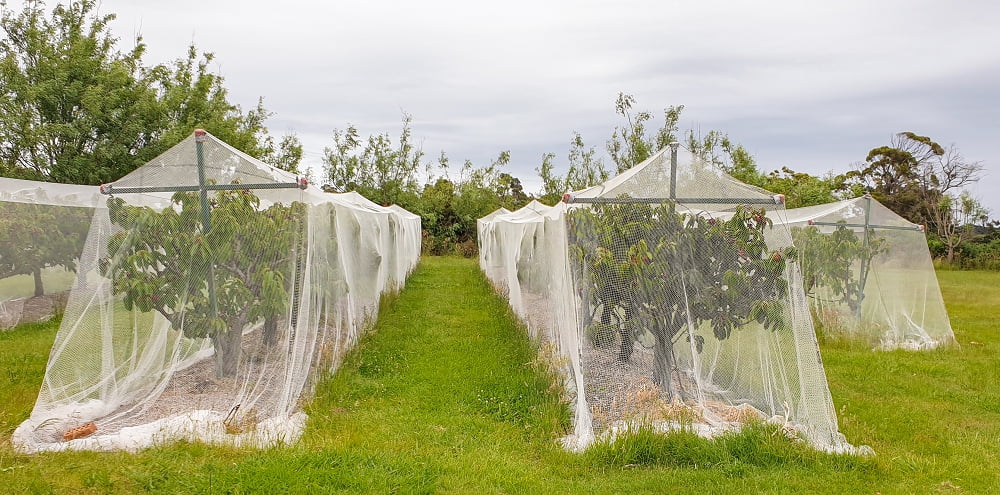


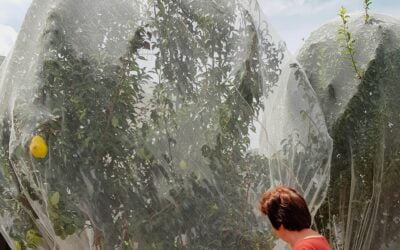



We are looking to buy fruit nets. Have been unable to source nets large enough to go over the piped tunnel design you show. We would like to use the small holed netting so the birds feet don’t get caught in the net. Any idea where to buy netting? I imagine commercial orchards aren’t sewing them together. We live in Sedgwick. Thank you for emails. Chris and Sandy
Hi Sandra, 10M, 15M & 20M wide nets available at some suppliers ( check out on the internet) but you may need to buy 100 metres, quality can also vary a lot. Oh and a tip to remember some types of net shrink in length when stretched down over hoops etc. Bernie.
One supplier of net which complies with new Victorian legislation is Haverford (in NSW).
I got a large sized net from peter Land? who is on the Mount Alexander Fruit Fly facebook page…think it would fit over large tree with piping? Slips over very easily as a bit “shiny” and has tie off at bottom.
Without wanting to favour one supplier over another, we’ve dealt with Netpro for our farm nets and been happy with the quality and service. Thanks for the recommendation for Peter Land Chris.
Hello,
I’m planning on roofing our orchard which is fenced with 2m high chook mesh.
The plan was to attach ploy over star pickets attached to the posts and make a tunnel. the bigger area is 10mx12m approx. How close or far apart should the poly supprts be? what tips do you have for installing a big piece of netting? Do you use cable ties or something else to attach it?
Thanks Cathy
Hi Cathy, great idea to net your orchard! A poly pipe tunnel will be tricky over such a wide area. Generally we use them for a single row of fruit trees, so about 5m wide at the most. Can you possibly net your area as two tunnels? To do this your trees would need to be in rows.
If that’s not possible, you’ll need to think in terms of a structure with a flat roof that enables you to stretch a net over it.
You may find our short course on bird netting and types of systems useful.
What time of the fruiting do you cover them. When they are little or when the fruit has grown.
I thought long and hard before I planted my fruit trees in my residential block, as I had problems with birds at the last place. So, I put in three rows of ‘trellis’ (similar to grape vines trellis only higher) and espaliered my fruit trees to a max of approx. 2.5 m high. A standard bird net can go over the trees/trellis and be wrapped up under the bottom of the trellis to completely exclude birds. Only problem is that it does not exclude earwigs, rodents and cherry slug! These pest require alternative strategies which Katie and Hugh cover well on the website.
In a small area I have apples, pears, cherry plum and lemon & lime.
In my espaliered mini-orchard, I also mulched over the are prior to planting and have no major weed problems as a result. Only problem is that the soil has improved so much that if I drop some seeds or the birds import them they grow really well where they drop. Nice to have say an understorey of rocket, tiny tom tomatoes or parsley etc.
Hi David, thanks for sharing this, it’s a great example of how a bit of thought and planning can create a great solution. And even though it can be a bit of work to set it up, it’s so good once it’s done, and you usually only have to do it once.
Do not use cable ties Cathy! They perish over time in the sun then snap off. I have had to sew up my whole orchard net as the contractor used them.
Just a reminder for those in Victoria that netting on trees must be white, have a mesh size of 5mm x 5mm or less at full stretch and be made from material with a strand diameter thicker than 500 microns or with a cross-weave design this is to reduce injuries and fatalities to wildlife. Bird netting as such is no longer legal.
This is all true. It’s also worth noting that this regulation does not come into force until September this year. And just so there’s no confusion, bird netting as such will not become illegal – just bird netting with a mesh size larger than 5 mm.
Here’s one supplier we know of with nets that comply with the new Victorian regulations. They’re actually in NSW 🙂 5mm bird netting
Does this apply to netting currently in use as well as new purchase?
This does apply to all net in use and for sale from that date. Note that this applies to noncommercial growers (i.e., home and backyard growers) only and not to commercial growers.
I know you are all focussed on protecting your fruit after much hard work, but the legislation in Victoria is for a very good reason – I have had to rescue one half-strangled lorikeet from my neighour’s netting (Dec. 2023), while they were on holidays. The small-holed netting on another tree has not caused any problems. Sadly, I have just noticed a dead bird stuck where it got caught in the larger-holed netting over his fig tree this month (April 2024). If you don’t want this distressing sight, please use the smaller version, whether it is legislated in your state or not.
Where can I buy fruit fly netting 10mx 10m tunnel design ?
Three suppliers we know of:
NetPro, QLD, also have an eBay store.
Monbulk Rural Enterprises, Victoria
Environet Canopies, South Australia
Note that from September this year nets in Victoria must be white and have a mesh size of 5mm or less.
I have espaliered all my fruit trees so they are very easy to net – I have had a good crop of Moorcroft apricots (delicious!) but am wondering why some of the fruit has split?
Hi Myra, splitting in fruit is usually an irregular watering issue, but can be caused by environmental conditions (like a really wet period), or sometimes it can follow on from other conditions like Freckle.
silly questions but had nets before and the dam rats eat holes everywhere along the bottom, so will be using chicken wire down low now. Can cockatoos or any other birds eat holes in bird nets above??
thanks
When is the best time to put nets on fruit trees, esp. cherry and peach trees?
Great article, thanks! What size poly pipe do you use to make the tunnel? We have a large cherry tree and the pipe we used this year bent and then was really difficult to remove.
What are the round reddish objects at the ends of your posts that keep the netting up and off the branches without damaging the netting?
Thanks for your help.
Hi there, this is simply red gaffer tape wrapped around a rag on the end of each post or crossbar.